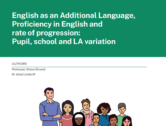Explore our policy recommendations for breaking down language barriers
in schools, adult education, and the criminal justice system.
English as an Additional Language, Proficiency in English and rate of progression: Pupil, school and LA variation
The University of Oxford, with The Bell Foundation and Unbound Philanthropy, have published a report which is the fourth and final in the research programme which investigated the relationships between English as an Additional Language (EAL), Proficiency in English and the educational achievement of EAL learners at school.
About the research
The University of Oxford, with The Bell Foundation and Unbound Philanthropy, have published a report which is the fourth and final in the research programme which investigated the relationships between English as an Additional Language (EAL), Proficiency in English and the educational achievement of EAL learners at school.
It is important to note that this research has been published in March 2021. Over the last year the global pandemic has caused schools to close for significant periods of time, as a result of which most children have experienced some degree of learning loss, and that loss is significant for pupils who speak English as an Additional Language who may have also experienced language learning loss during this period. This is why this research programme is so important as it provides schools and policy-makers with key insights on EAL learner attainment and the need for appropriate catch-up support and resources to enable EAL learners to mitigate the language and learning lost during school closures.
As with the 2020 report, the research team Professor Steve Strand and Dr Ariel Lindorff, Department of Education, University of Oxford, analysed Proficiency in English data from the Welsh Pupil Level Annual School Census (PLASC). The Welsh Government has been recording the Proficiency in English of pupils annually since 2009, which provided data for this cross-sectional and longitudinal study. In total 3,528,064 anonymised pupil records across a nine-year period (from Reception to Year 11) were analysed. As the data is recorded using the same five-point Proficiency in English scale as the one used in England in 2017-2018 the research team found that the EAL group in Wales is therefore comparable to that in the English National Pupil Database and therefore the findings are as relevant in England as they are in Wales.
One of the key findings in the latest report is that schools and Local Authorities (LAs) vary substantially in their approach to the assessment of Proficiency in English, the result of which is a marked variation in the average time it takes pupils to progress between Proficiency in English levels. The report concludes this variation is strongly influenced by the person conducting the assessment, rather than a difference in pupils themselves. This is important as previous research has shown that Proficiency in English is central to understanding achievement and levels of need for language support among pupils who use EAL, and therefore consistent and accurate assessment is crucial.
The latest report builds on, and extends, previous research (Strand, Malmberg and Hall (2015), Strand and Hessel (2018) and Strand and Lindorff (2020)) which show that, amongst other findings, EAL learners are a hugely diverse group, that two-thirds of pupils who start as new to English require more than six years to gain the academic linguistic proficiency to fully access the curriculum, and the empirical link between Proficiency in English and pupil achievement and, as a result, the level of support learners need in order to achieve their academic potential.
This study set out to answer four questions which are of central importance for teachers, curriculum developers and policy-makers:
- How much variation is there between schools and between LAs in the time it takes pupils to progress between levels of Proficiency in English?
- To what extent are pupil characteristics (gender, ethnicity, entitlement to a Free School Meal (FSM) and special educational needs) associated with the time it takes pupils to progress between levels of Proficiency in English?
- How are KS1 and KS2 attainment related to pupils’ EAL status and levels of Proficiency in English?
- What happens to pupils’ levels of Proficiency in English in the transition from primary to secondary school? What might this tell us about consistency in the recording of Proficiency in English?
Key findings include:
- There is no evidence that being in a school with a high proportion of pupils acquiring Proficiency in English has any negative association with achievement for other pupils in the school, either overall or specifically for pupils with First Language English.
- Schools and LAs vary substantially in their approach to the assessment of Proficiency in English, the result of which is a marked variation in the average time it takes pupils to progress between Proficiency in English levels. The report concludes this variation is strongly influenced by the person conducting the assessment, rather than a difference in pupils themselves. Therefore, in order to provide EAL learners with the correct type and level of support to progress through the levels of English language proficiency there needs to be on-going and consistent language proficiency assessment.
- Proficiency in English is strongly related to levels of educational achievement at KS1 and KS2. EAL pupils who are starting to acquire proficiency score below the national average, those who are at mid-point proficiency are very close to the national average and those with the highest levels of proficiency typically score higher than First Language English speakers.
- However, it takes two-thirds of pupils who are new to English at the start of Reception more than six years to progress to the highest levels of proficiency. This is important as it demonstrates that EAL pupils who are acquiring proficiency need additional support in order to achieve academic success.
- 70% of secondary schools reclassified at least 5% of the EAL pupils in their intakes. One notable finding was that pupils assessed as fluent in Year 6 were much more likely than others not to be assessed as using EAL in Year 7, with 24% of fluent EAL pupils reclassified as First Language English/Welsh compared with just 4% of pupils at the lowest levels of proficiency. This may have been an intentional decision on the part of the secondary school if these pupils were no longer seen as having language support needs, and may account for the overall reduction between Y6 and Y7 in the percentage of pupils recorded as EAL (from 6.9% to 6.2%). However, this implies that there is a misunderstanding about what the term ‘EAL’ means, with some thinking that it is related to the need for support as opposed to a pupil ‘who speaks another language at home or in the community’.
Key Recommendations for schools:
The research programme demonstrates the importance of robustly assessing and recording the Proficiency in English of all learners using EAL. Through initial and on-going assessment of both language proficiency and cognitive skills, schools can establish the level of need among individual learners. Through setting tailored targets and support strategies for teaching and learning, teachers can support their learners to progress to higher levels of proficiency. Through achieving academic linguistic proficiency learners will be able to fully participate in school and access the curriculum and, as a result, to fulfil their academic potential. This is particularly important after prolonged school closures, or absence from school, as it will help to mitigate any learning loss during those periods. School staff can download free assessment tools and resources here.
Key Recommendations for the Government:
- As Proficiency in English is the major factor influencing the educational achievement and the degree of support a pupil using EAL will require, the Department for Education (DfE), in line with the other devolved nations, should introduce a statutory requirement for schools in England to assess and record (for their internal monitoring purposes) EAL pupils’ level of Proficiency in English using the DfE’s previously used five-point assessment scale which was trialed in England for two years and is currently in operation in Wales, Northern Ireland and Scotland
- Schools should be provided with guidance on undertaking robust and consistent assessment, moderation and recording of Proficiency in English levels to ensure they can apply the correct interventions
- Teachers at the start, and throughout their careers, should be provided with training and Continuing Professional Development on how to assess Proficiency in English to ensure consistent and on-going measurement. Training should also include how to support learners to progress to the highest levels of proficiency and therefore to achieve their academic potential.
- Recognition of the fact that Proficiency in English has a direct relationship with attainment for EAL learners and that continued language support is essential in the system, particularly for those learners who have experienced significant language and learning loss during school closures
- The evidence shows that it takes the majority of EAL learners who start school as new to English more than six years to achieve Proficiency in English which is longer than the current maximum of three years of funding provides for. Therefore the DfE should consider extending funding to provide support for those learners at the lowest levels of Proficiency in English, and those arriving late into the school system.
The executive summary of the report is available in Welsh and the full report in English.




